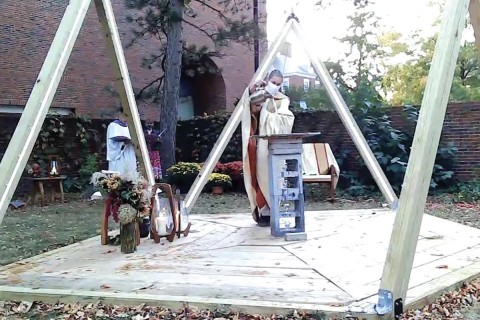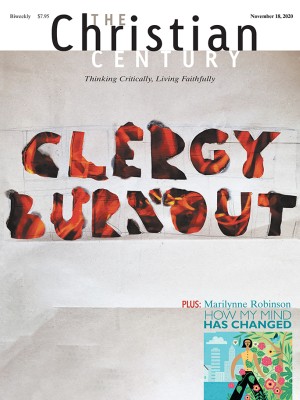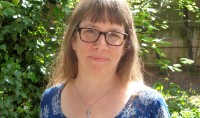A tent for outdoor worship
The stark liturgical space that Harvard Episcopal chaplain Rita Powell envisioned before COVID is now a reality.

Such is the strangeness of these days that recently I settled down in front of my computer to watch a liturgy happening only a few blocks away. My colleague Rita Powell, our Episcopal campus chaplain, was consecrating a sacred tent she had already commissioned when COVID-19 arrived. Rita knew we were in the wilderness long before the pandemic shut down our churches and our classrooms. Even before we were driven out of doors, she saw that we needed new sacred spaces to “honor the God who meets us in the wilderness of our world.”
The liturgy began in the park across the street from the chaplaincy. Benjamin Bromberg Gaber, a recent design school graduate and the architect of the tent, read from Exodus—in Hebrew and then English—about the tent of meeting Moses pitches outside the camp so that he can speak to God “face to face, as one speaks to a friend” (33:11). In her homily, Rita reflected on what it means to dwell in the wilderness with God. The wilderness is the place of our undoing, she said—the undoing of patterns, including religious patterns, that have oppressed us and others—and also a place of liberation, where new ways of being and belonging might come into view. Then two singers sang medieval chants composed for the blessing of cathedrals. The moment felt both ancient and new.
Read our latest issue or browse back issues.
The small group turned and made its socially distanced way toward the chaplaincy, waiting in their masks and vestments for the light to change. After a prayer from the dean of the cathedral in Boston, they entered the back garden through the gate, one by one. The camera came in behind them, and suddenly the sacred tent came into view on my screen.
I had imagined something akin to a circus tent, but churchier. Something covered in brightly colored fabric, with the wind blowing through it. What the sacred tent turned out to be was a stark structure, absolutely open, so open that it almost seemed part of the natural world itself. It was a wooden structure with a pentagonal floor and wood-beam triangles on three sides, each rising to a point in the air; it was a cathedral pared down to its ribs. The altar was a couple of stacked cinder blocks, and there was a cast iron skillet where the incense would burn. It was a holy place fashioned from the stuff at hand, like the house for God Jacob made from the stone he had used for a pillow the night he dreamed of the angels on the ladder.
To be at home in this moment when we have lost our bearings, Rita told us, we are going to need new dwellings. To bless this one, she poured water over the cinder block altar. She lovingly asperged the tent’s floor and beams with wet branches and then anointed them with oil. To be at home in this moment of disorientation, she said, we also need forms of time not patterned by buying and selling but by creation itself. We need liturgical time, which gathers up the past and the present and helps us to dwell in the midst of eternity, even as everything passes away.
We are reminded each year on Sukkot of the importance of ephemeral sacred spaces as sukkahs appear around campus, adorned in greenery, filled with people eating and talking, coming and going. These temporary shelters make our wilderness visible, along with the holiness of our encounters there. Our Jewish siblings are our great teachers when it comes to understanding that sacred space can open within time itself. Abraham Joshua Heschel famously wrote that “the Sabbaths are our great cathedrals.” No matter where one is on Friday night, the Sabbath opens its great doors.
Rita and her students and colleagues created the sacred tent to be a similarly welcoming open space. But the students with whom Rita first imagined this space were forbidden by COVID-19 regulations to gather there for the consecration. As open to the protective breezes as the tent is, most of us still had to experience it remotely. We couldn’t stand around the cinder block altar or smell the incense burning in the skillet or be anointed with the same oil Rita was using to press God’s seal into the wood. We had to gaze from a distance, separated by the very space and time into which the sacred tent is meant to invite us. But that distance is part of the wilderness in which God waits to meet us. Even with our screens limiting our vision, the sacred tent did its work, framing the world as wholly God’s and drawing us upward and together toward an unknown future along the lines of its triangular beams, the ones Rita stretched up on her toes to bless.
A version of this article appears in the print edition under the title “A stark tent for worship."







